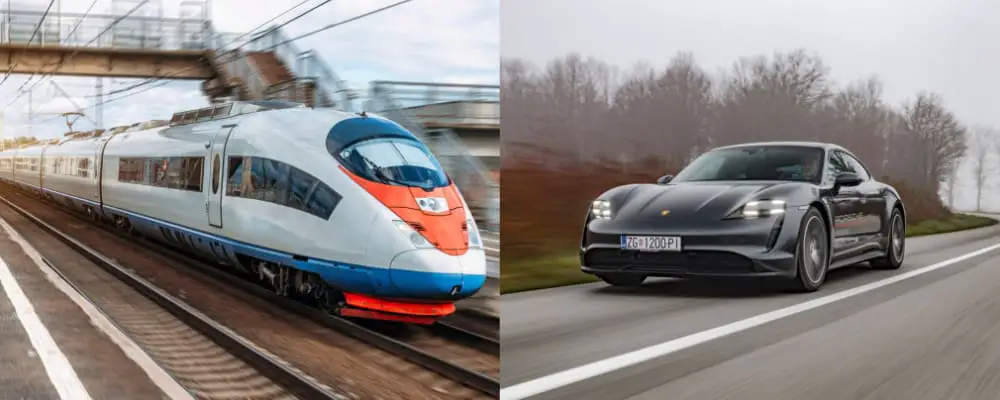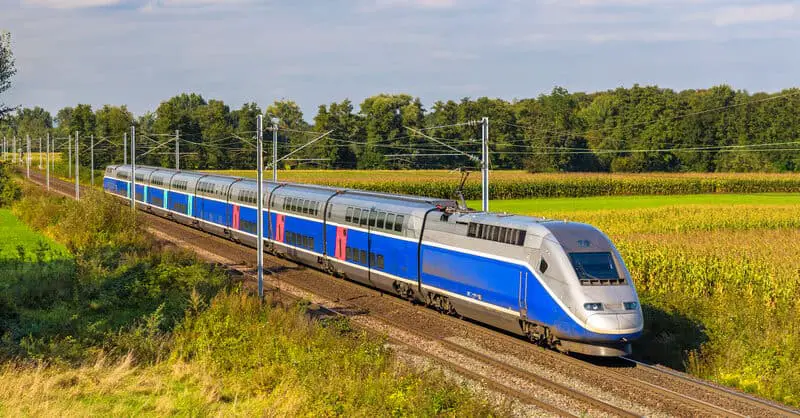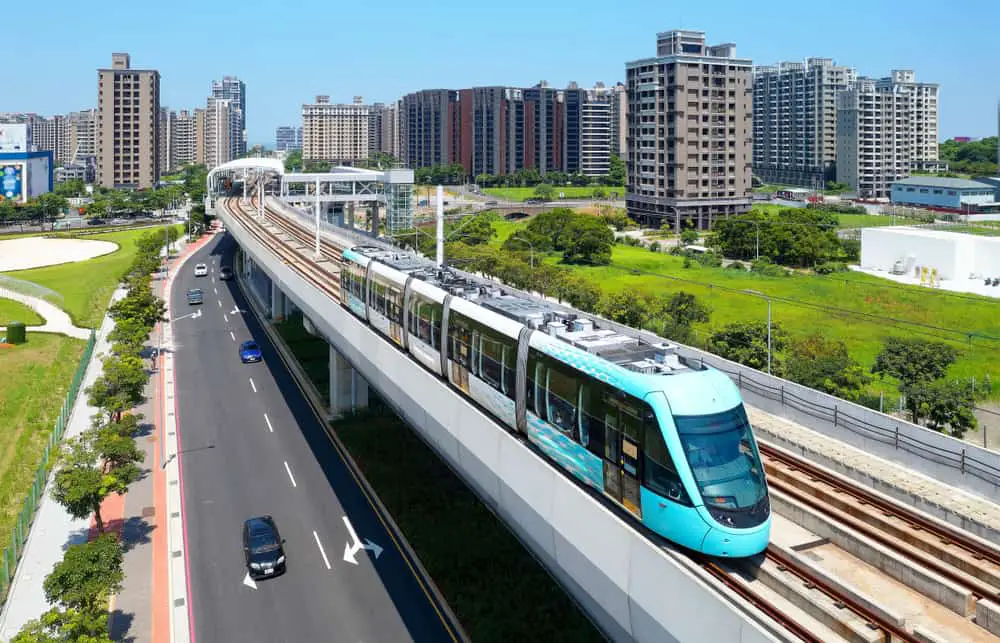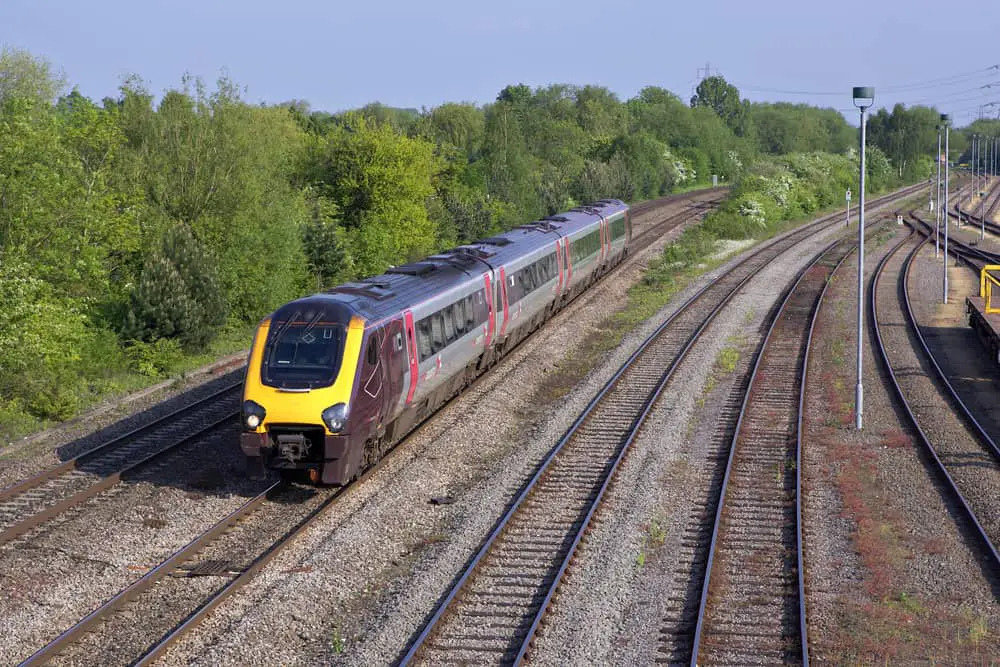
Suppose you research the most common mode of transportation. In that case, you will typically conclude that the championship battle is between trains and cars.
In some countries, there are more cars, and in others, people prefer to use trains. But have you ever wondered which of them is faster?
The fastest street-legal car in the world is faster than the fastest commercial passenger train. However, In countries where high-speed trains are standard, they are typically much quicker modes of transportation than cars. Trains are not bound by speed limits or inhibited by traffic.
There are a few ways to approach the question of whether trains are faster than cars. And the answer may depend on the context. So, while it may not be as simple as a drag race, some interesting facts exist.
Trains Vs. Cars: Which Is Faster?
First, let’s go through the fastest passenger trains and the faster road-legal cars.
Here are the fastest commercial passenger trains:
| Train | Max Speed | Country |
|---|---|---|
| 1. Shanghai Maglev | 268 mph (431 km/h) | China |
| 2. CR400AF /BF | 249 mph (400 km/h) | China |
| 3. CRH 380A | 236 mph (380 km/h) | China |
| 4. Shinkansen E5, H5 | 224 mph (360 km/h) | Japan |
| 5. AGV Italo | 224 mph (360 km/h) | Italy |
Here are the fastest road-legal cars:
| Car | Max Speed |
|---|---|
| 1. Bugatti Chiron | 304.7 mph (490 km/h) |
| 2. SSC Tuatara | 295 mph (475 km/h |
| 3. Koenigsegg Agera RS | 277.8 mph (447 km/h) |
| 4. Hennessey Venom GT | 270.4 mph (435 km/h) |
| 5. Bugatti Veyron | 267.8 mph (431 km/h) |
As you can see in the tables above, the cars are superior when it comes to top speed. However, there’s more to this debate than just comparing the fastest vehicles.
If we are going to decide on a conclusive winner between cars and trains, we have to consider a few scenarios.
Modern Trains Reach Higher Speeds Than Cars

In European and Eastern countries, trains are a common mode of public transportation. Their popularity has also steadily increased, leading countries like Japan to continuously develop their rail systems.
The result is that trains in those countries are continually becoming faster.
A perfect example of this evolution is Japan’s L0 Maglev train. The term “maglev” is derived from the fact that it floats or levitates above the track using electromagnetic energy. This is also known as magnetic levitation, or maglev for short.
This technology removes ground friction from the equation, and the train only has to compete with air friction. The result is a train that can reach a ridiculous speed of 374 mph or 602 kph.
This train isn’t used as a commercial passenger train as of now, thus not included in our list above of the fastest trains.
Conversely, the fastest street-legal car is the Bugatti Chiron Super Sport, which can hit a top speed of 304.7 mph.
“But the 374 mph of the train was only reached for a few seconds,” I hear you say. But, with a standard operating speed of 314 mph, it’s still much faster than the Bugatti.
And what you may need to know is that the Bugatti can only maintain that speed for about 15 minutes, after which the tank is empty, and the tires will need to be replaced. So, while the car may be fast, it’s incredibly impractical.
Modern Trains Can Maintain Higher Speeds Than Cars
Even if a new car suddenly hit the market that doubles the speed of the L0 Maglev, it would still be slower than a train.
The old parable of the race between the hair and the tortoise is the perfect explanation. You see, while supercars can hit high speeds for short bursts, they are mechanically unable to maintain those extreme speeds.
And, even if you could build a car that could maintain those speeds indefinitely, it would likely still lose against a train. This is because the road infrastructure isn’t built to support high speeds.
You would have to be a professional racing car driver to maintain a speed of 120 mph between any two given towns. Roads have sharp turns, potholes, animals, reduced visibility, and a giant bag full of other uncontrollable influences. All of these mean that you will be hitting the brakes more often than not.
On the other hand, modern high-speed trains can maintain higher operational speeds. The high-speed rail system is built to accommodate high speeds. This means it eliminates most of the negative influences you find on the road.
For example, the turns and bends are built so that higher speeds can be maintained through them. Furthermore, tracks don’t suffer wear and tear in the same fashion as roads, so you won’t be slowing down for a pothole anytime soon.
Trains Are Typically Faster In Cities

It should come as no surprise that trains are a faster mode of transport in the cities of countries that have developed high-speed rail systems.
The biggest reason for this is that trains are not slowed down by traffic or rush hours. You will likely need to wait your turn to get on board, especially in Japan, but the train will reach its destination before a car.
However, this isn’t universally true. Asia and Europe have excellent rail systems. Unfortunately, the same can’t be said for most of Africa and even parts of the Americas. You may be better off driving your car in some US cities because the trains aren’t that great.
In Cape Town, South Africa, you should definitely opt for a car if you want to reach your destination without getting mugged or attacked.
But for those cities that have invested in sound rail systems, trains will almost always be faster than cars.
Trains May Be Faster Cross Country

The same applies to trains going cross-country. In countries developing high-speed rails, it is extremely unlikely that cars could ever be built to match their speed.
For example, the L0 Maglev covers the 178-mile journey from Tokyo to Nagoya in just 40 minutes. The same trip takes 4.5 hours in a car.
In the USA, where rail technology has fallen behind somewhat, it’ll take 3 to 4 days non-stop to ride a train from San Francisco to New York.
The same trip will take you around 45 hours in a car. But in reality, you can only really drive for about 8 hours a day, so you will take 6 days to reach New York.
Similarly, the train journey between Johannesburg and Cape Town in South Africa takes around 26 hours. In contrast, the trip by car takes only 15 hours. But this, again, is due to a lack of research and development in railways.
Sure, the Japanese L0 Maglev may be an extreme example, but trains don’t have to be quite so extreme to dominate. For example, in Italy, where more typical high-speed rails are in use, a train ride from Rome to Milan will take around 3 hours. Which is half the time of the 6-hour drive.
You would have to drive a consistent speed of 120 mph to match the speed of that train, something which I don’t see even as a possibility for cars.
Conclusion
In almost all cases where countries have developed high-speed rail systems, trains are much faster than cars.
Even in cities without high-speed systems, trains may be faster because they are not bound by traffic. However, in less developed countries, rail systems have fallen behind the speed of cars.
